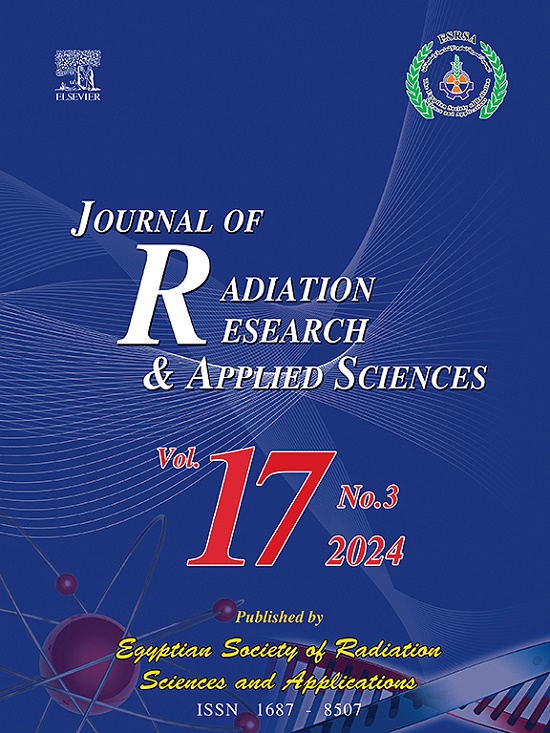Magnetohydrodynamic flow of carbon nanotubes blood based hybrid nanofluids with the impact of thermal radiation over a permeable surface
IF 1.7
4区 综合性期刊
Q2 MULTIDISCIPLINARY SCIENCES
Journal of Radiation Research and Applied Sciences
Pub Date : 2025-03-08
DOI:10.1016/j.jrras.2025.101408
引用次数: 0
Abstract
This study looks at the magnetohydrodynamic (MHD) flow properties of blood-based hybrid nanofluids (HNFs) containing carbon nanotubes (CNTs), such as SWCNTs and MWCNTs with multiple walls. Thermal radiation is present during the study. The study is mostly about how these fluids behave on a permeable surface in steady-state laminar flow. To make things easier, boundary layer (BL) approximations are used to simplify and solve the equations for momentum and energy. We transform these equations into a system of nonlinear ODEs via similarity transformations (STs) and solve them semi-numerically. This study looks at how surface permeability, magnetic field (MF) strength, and thermal radiation affect the flow and heat transfer properties of fluids. It does this by looking closely at key parameters like the permeability parameter, the radiation parameter, the power law index, the CSP, the nanoparticle volume fraction (VF), the heat generation, the Eckert number (EN), and the MF strength. The results, which are shown in the form of graphs and a table with the NN and skin friction (SF) coefficients, give us important information about how blood-based (BB) HNFs with CNTs behave in MHD conditions. The moment of HNF particles decreases as the magnetic parameter (MP), CSP, and nanoparticle volume friction all go up. However, this has the opposite effect on the temperature profile as the EN, radiation parameter, heat generation parameter, and nanoparticle volume friction all go up. This study shows how important permeability and thermal radiation are in changing these dynamics. It also helps to create better ways to control temperature in engineering and biomedical settings.
热辐射影响下碳纳米管血基混合纳米流体在可渗透表面的磁流体动力学流动
本研究着眼于含有碳纳米管(CNTs)的基于血液的混合纳米流体(hnf)的磁流体动力学(MHD)流动特性,如具有多壁的SWCNTs和MWCNTs。研究过程中存在热辐射。研究主要是关于这些流体在稳态层流中在可渗透表面上的行为。为了简化问题,边界层(BL)近似用于简化和求解动量和能量方程。我们通过相似变换(STs)将这些方程转化为非线性ode系统,并进行半数值求解。本研究着眼于表面渗透率、磁场(MF)强度和热辐射如何影响流体的流动和传热特性。它通过仔细观察关键参数,如渗透率参数、辐射参数、幂律指数、CSP、纳米颗粒体积分数(VF)、产热、埃克特数(EN)和中频强度来实现这一点。结果以图表和表的形式显示,其中包含神经网络和皮肤摩擦系数,为我们提供了关于含碳纳米管的血基(BB) hnf在MHD条件下的表现的重要信息。随着磁性参数(MP)、CSP和纳米颗粒体积摩擦力的增大,纳米颗粒的力矩减小。然而,这对温度分布有相反的影响,因为EN、辐射参数、产热参数和纳米颗粒体积摩擦都增加了。这项研究表明,渗透率和热辐射在改变这些动态方面是多么重要。它还有助于创造更好的方法来控制工程和生物医学环境中的温度。
本文章由计算机程序翻译,如有差异,请以英文原文为准。
求助全文
约1分钟内获得全文
求助全文
来源期刊

Journal of Radiation Research and Applied Sciences
MULTIDISCIPLINARY SCIENCES-
自引率
5.90%
发文量
130
审稿时长
16 weeks
期刊介绍:
Journal of Radiation Research and Applied Sciences provides a high quality medium for the publication of substantial, original and scientific and technological papers on the development and applications of nuclear, radiation and isotopes in biology, medicine, drugs, biochemistry, microbiology, agriculture, entomology, food technology, chemistry, physics, solid states, engineering, environmental and applied sciences.
 求助内容:
求助内容: 应助结果提醒方式:
应助结果提醒方式:


